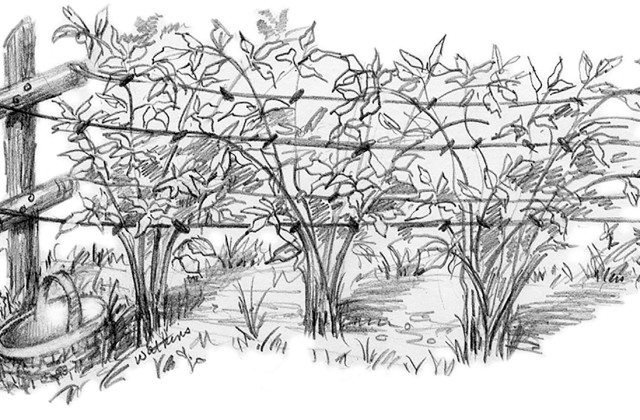Through the Garden Gate
July, Berry Season
By Leslie Watkins
July is the beginning of the great berry harvest, keeping both people and birds busy as can be. Blueberries, red raspberries, blackcurrants and gooseberries all begin to ripen now, providing us with delectable and nutritious berries for pies, tarts, sauces and pancakes—if the berries make it back to the house in sufficient quantities. There are few more satisfying investments in our gardens than a blueberry grove or a raspberry hedge. They require a bit of maintenance initially, but reward our efforts for many years to come.
Our native blueberries require acid soil and good drainage. All berries benefit from plenty of sunshine. Cultivars are available as lowbush, highbush or half-high plants. Different varieties will ripen early, mid- or late season, providing berries from June through August and maybe longer. To grow them well, select a sunny, well-drained spot and test the pH of the soil. Ideally, the pH should be between 4 and 5. If not, amendments of sphagnum peat moss, sulfur, pine needles and shredded bark will help lower the pH, improve tilth and acidify the soil. It takes time to prepare the soil properly, so plan well ahead. Blueberry bushes will take up to six years to grow into full production, but once established they will provide you with plenty of antioxidants, help improve your memory and also regulate blood sugars. They provide vitamin K, vitamin C, manganese and fiber.
Raspberries require a little more effort if you want the best yields, but are much quicker to get established. Plants should be kept damp in summer and dry in winter and fed well with rotted manure rich in nitrogen. Training the canes on a trellis, along a fence or using 12-gauge wire, can make working them much easier.
For the wire method, set a sturdy post at either end of your row, with a center post if need be. The posts should be seven or eight feet long and sunk three feet into the ground. Attach two crosspieces to each post, the first about two feet and the second about four feet from the ground. String lengths of wire along the row so that the lower crosspieces hold the wires parallel about 18 inches apart, and the higher crosspieces hold the wire about 30 inches apart. This will allow you to tie canes to the wire in a V position to allow plenty of air circulation and as much sunshine as possible. Canes will need regular pruning to remove weak and old canes and to encourage strong plants. This work is best done in late winter or early spring.
Blackcurrants and gooseberries are easy and very productive. They need sun and rich, well-drained soil. Their lower branches need to be removed. They may be espaliered on a fence to save space and are very attractive that way. They are more tart than blueberries and raspberries but just as nutritious. Packed with anthocyanins, blackcurrants are potentially beneficial in relation to cancer, aging, inflammation and neurological diseases.
All these beautiful and delicious berries are brought to you by your friendly pollinators, without whose help we would have no berries. Show your appreciation by being responsible with chemical pesticides and stay organic. Be aware that some organic pesticides and herbicides are harmful to bees too. Be sure to read and understand labels and usage.
Best Blueberry Crisp Recipe
This is the easiest, most delicious crisp recipe. You can substitute just about any other berries or mix them all in together. Extra topping may be set aside for future use. Preheat oven to 375º.
The Filling:
6 cups blueberries (or other berries)
1 tablespoon cornstarch
¼ cup sugar
The Topping:
1 cup all-purpose flour
1 cup sugar (or ½ cup brown and ½ cup white)
1 cup oats
1 cup chopped walnuts or pecans
1 stick butter, room temperature
¼ teaspoon cinnamon
¼ teaspoon nutmeg
- Gently toss filling ingredients together in a bowl.
- Combine dry topping ingredients and pinch in butter until mixture is crumbly.
- Put berry mixture into a baking dish and top evenly with crumb mixture. Bake for 40 minutes and serve with ice cream.
July Chore Checklist
Plant a buckwheat patch in July for the honeybees.
Raise the blade on your lawnmower.
Check for tomato hornworms and cabbage worms.
Keep pulling weeds before they can reseed.
Water as needed, especially newly planted trees and shrubs.
Pick cucumbers and summer squash while they’re young.
Sow fall harvest crops: kale, cabbage, beets and carrots.
Deadhead and cut back flowers to encourage rebloom.
Make garlic scape pesto.
Freeze fresh-picked berries for later use.
Enjoy a berry smoothie with yogurt and maple syrup.
Illustration © Leslie Watkins 2016.

